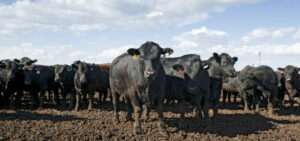 By Sydnee Shive
By Sydnee Shive
Kansas Living Magazine
Did you know most of the beef you see in the grocery store started as a steer alongside his mother? Many times we say we’re eating “cow,” but that’s not accurate. In ranch terms, a cow is a female that’s had at least one baby, and a steer is a castrated male. He’s born, and he becomes a steer, and eventually goes to a feedlot to gain weight. A feedlot is an area where large groups of livestock are fed in preparation for slaughter. Cattle go from the feedlot to a processing plant and then the grocery store.
When the steer was born, he stayed with his mom for the first six months of his life. Most of his nutrition came from nursing, and he was probably fed some supplemental grain or hay as he got older.
At six months, he weighed around 600 pounds and was ready to be weaned, or to transition to life without his mother at his side. Kind of like sending your kid off to college. The steer then moved to a stocker operation, where younger cattle go to gain weight before they head to a feedlot. At the stocker operation, he ate winter wheat or summer grass with other calves his age for an additional six to 10 months, until he was 800 pounds.
After he reached that weight, the steer moved to the feedlot he’s at today, and that’s where he’ll stay until he’s 1,300 pounds. The steer’s end goal: to supply beef to consumers. He’ll produce ground beef, roasts and that perfect medium-rare ribeye.
Most days in the feedlot are similar; the steer begins his day with breakfast. The menu on most mornings: a mix of feed consisting of hay, grain, minerals and vitamins. Too much grain can make cattle sick, and ranchers work hard to ensure their cattle get the right nutrition throughout the cattle’s entire life. The steer will eat this mix of feed one to three times a day, depending on how old he is and how he is growing.
The steer’s job is pretty simple at the feedlot. He just needs to grow and put on fat. He also gets to chill out with the other calves in his pen. The ranchers will closely monitor the steer for any sign of sickness, and they’ll give him some medicine if he looks unlike himself. If the steer isn’t feeling well, other calves could get sick too, or the steer may lose weight. Neither one is good for the calf, the producer or the consumer.
If everything goes right, the steer will reach his end goal of 1,300 pounds before he’s two years old, and he’ll head to the processing plant and eventually end up on your plate.
As the sun begins to set and the tractor can be heard in the distance, the steer heads to the bunk for his dinner. After he’s full, he’ll find a dry spot to lie down, and he’ll go to sleep for the night. When he wakes the next morning, he’ll find his way to the feed bunk again for breakfast.


